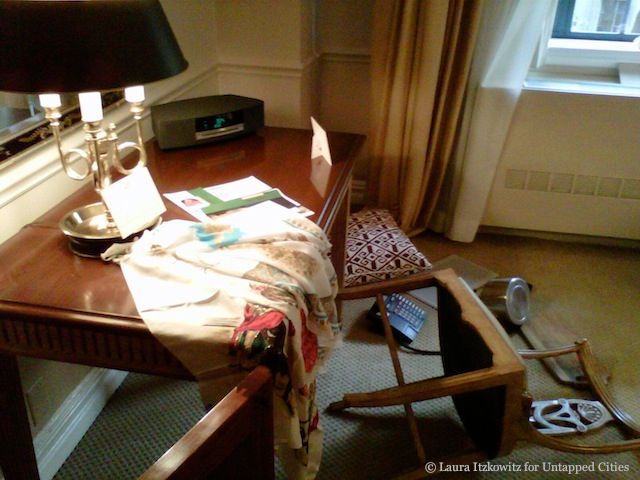Last Chance to Catch NYC's Holiday Notalgia Train
We met the voices of the NYC subway on our nostalgia ride this weekend!


At first glance, Sophie Calle’s installation art exhibit “Room,” at the Lowell Hotel seemed like a very precisely curated collection of everyday objects. Her room, Room 3A, which runs at $185o per night, was a classically decorated hotel suite full of things like clothes (both men’s and women’s), bags (including one of those canvas totes from The Strand), orchids, books, handwritten letters, a model Eiffel Tower, a typewriter, and a wedding cake, among other things. However, Calle collects more than just objects, she collects stories.

Each object in the room has a placard next to it with a brief anecdote numbered at the top suggesting a sequence to follow. They range from childhood memories to her marriage and divorce. While some of the stories are strange and funny, they often portray a sense of loss: lost love, lost life, lost innocence. Calle describes candidly her feelings about love and sex: the pain, the embarrassment, the fear and desire. The first placard tells the reader that when Ms. Calle was young, she was afraid of men; strange for a woman who has had so many lovers and who brings them into view so publicly. The idea returns later when she tells us that at 18 years old, she asked her lover not to let her see him naked from the front, only the back. During their whole yearlong affair, he complied with her wish.

On the placard that emerges from a typewriter, she tells us that she always asked her ex-husband to write her love letters, only to discover letters that he had written to another woman. In the bedroom, we see an overturned chair and several objects on the floor. Upon reading the placard on the desk, we learn that her ex-husband once threw these things at her in a fight. The stories she tells are deeply personal. There is something very sentimental in her longing to receive love letters and in her need to stage a fake wedding after she eloped with her ex-husband in Las Vegas (as she recounts the story in the placard near the wedding cake). Yet Calle is not simply a woman with her head in the clouds, caught up in her dreams and fantasies. She is fully immersed in the world around her, though it’s a very subjective vision of the world.

Several anecdotes involve people who wanted to engage her as an artist or simply as a compassionate, curious person interested in other people. On a placard placed on the bed, she tells us about a letter she received from a man who had recently gone through a painful breakup and asked if he could spend some time in her bed. (In one famous exhibition, Calle had actually invited people to spend 8 hours in her bed and documented it.) Instead of making the man travel from California to France-as his letter had seemed to suggest-she sent her bed to him along with her used bed linens. Several months later, he sent them back with a note saying that he liked her scent and that the pain had gone away. By highlighting her own idiosyncrasies, Calle shows us a way of relating to others.
“Room” was part of Fiction & Non-Fiction presented by the French Institute Alliance Française (FIAF).
Get in touch with the author @lauraitzkowitz.
Subscribe to our newsletter